University Reflective Essay: The Age 75 Recording, NUR1201, S2 2019
VerifiedAdded on 2022/10/06
|8
|2542
|36
Essay
AI Summary
This reflective essay analyzes a recorded interaction with a 75-year-old patient, exploring the patient's experience within the healthcare system. The essay employs Gibb's reflective cycle to examine the patient's reluctance to seek hospital care due to a negative past experience, the impact of a surgeon's brusque behavior, and the lack of fall prevention education. The discussion highlights the importance of a constructive nurse-patient relationship, the violation of ethical codes, and the significance of patient engagement in fall risk management. The essay emphasizes the need for empathetic care, reduced waiting times, and the integration of technology like 'My Health Record' to improve patient satisfaction and overall healthcare outcomes. The author reflects on the experience, acknowledging the importance of interpersonal skills and the need for continuous improvement in nursing practice, including providing patient education and utilizing electronic health records effectively.
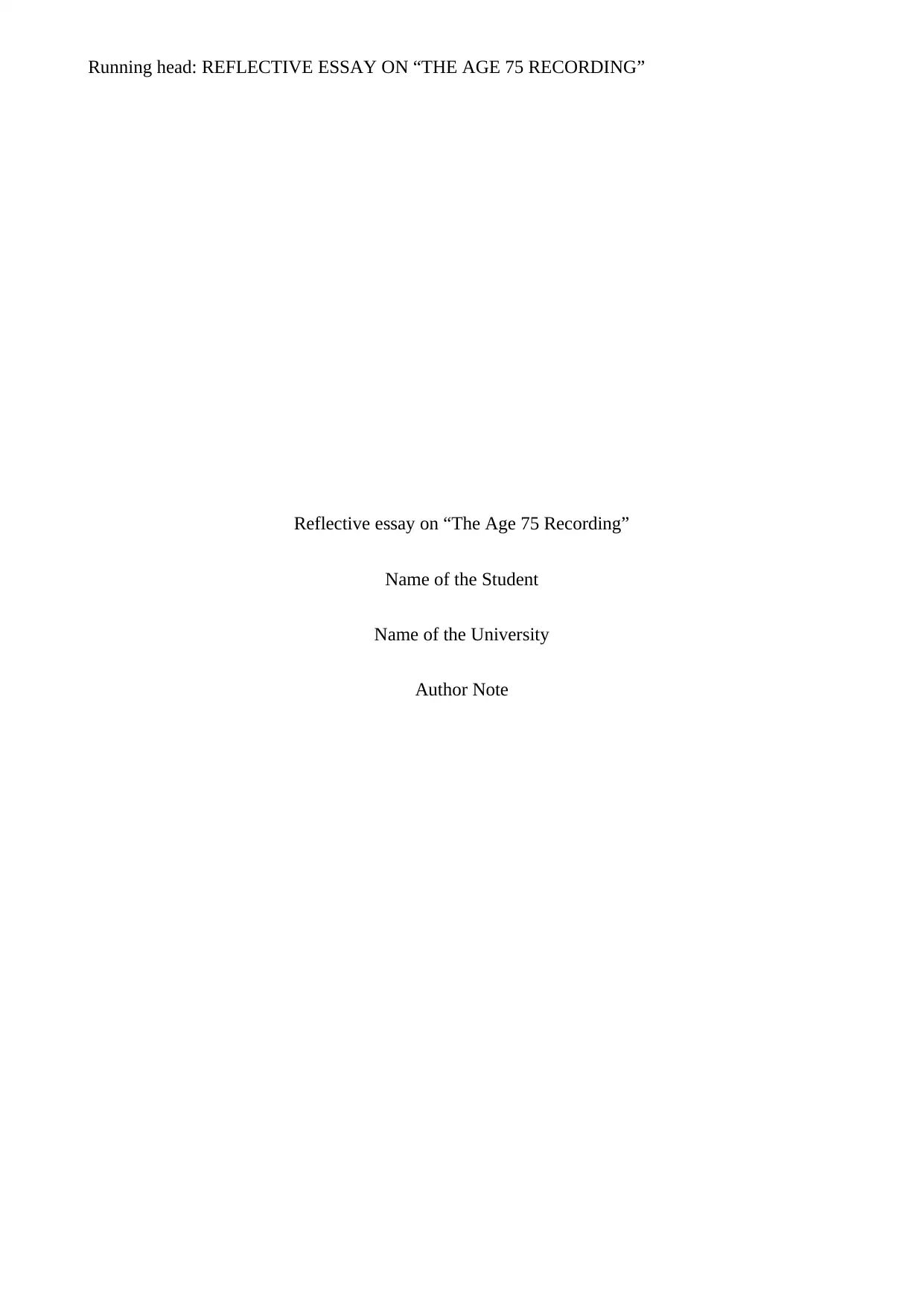
Running head: REFLECTIVE ESSAY ON “THE AGE 75 RECORDING”
Reflective essay on “The Age 75 Recording”
Name of the Student
Name of the University
Author Note
Reflective essay on “The Age 75 Recording”
Name of the Student
Name of the University
Author Note
Paraphrase This Document
Need a fresh take? Get an instant paraphrase of this document with our AI Paraphraser
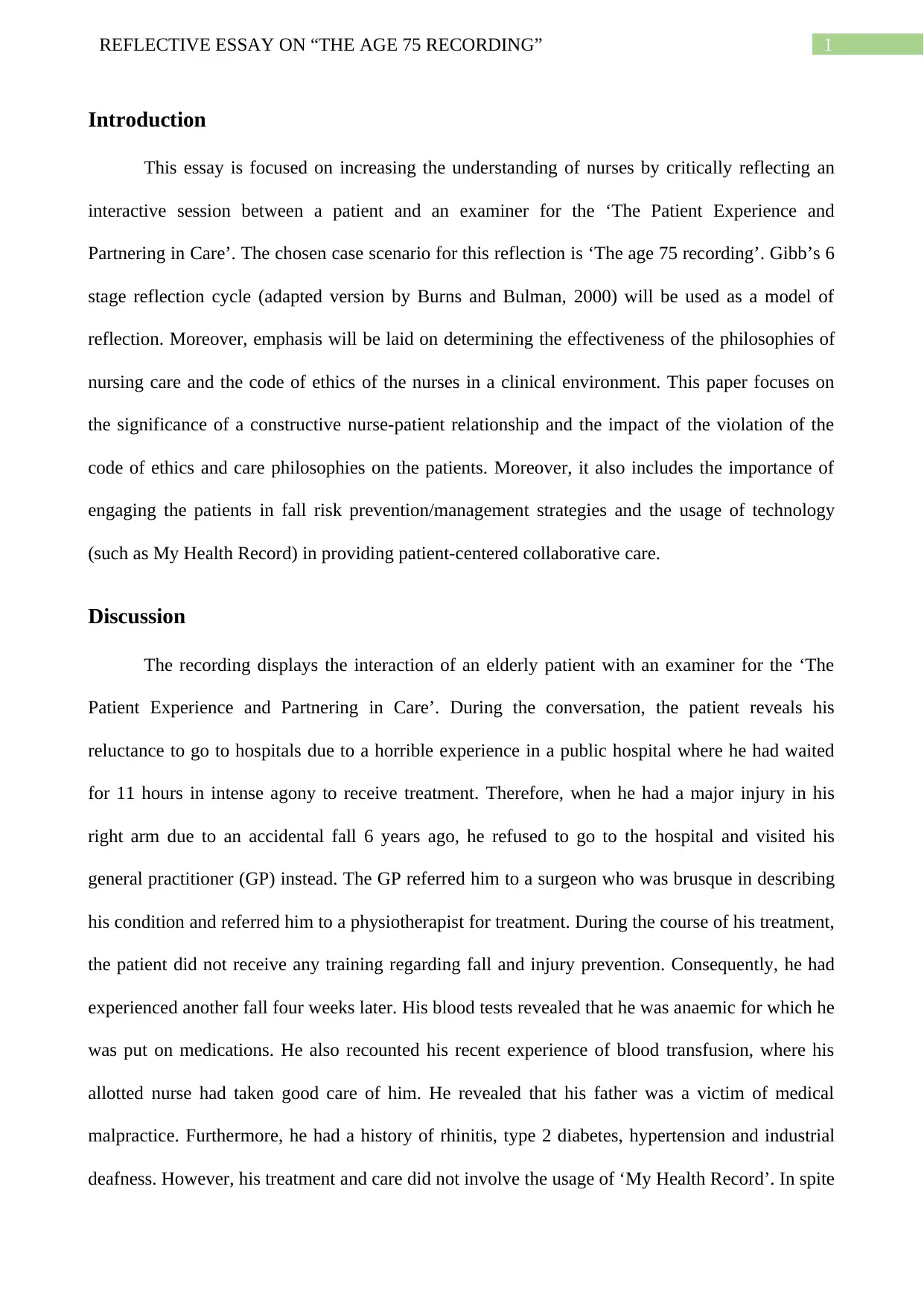
1REFLECTIVE ESSAY ON “THE AGE 75 RECORDING”
Introduction
This essay is focused on increasing the understanding of nurses by critically reflecting an
interactive session between a patient and an examiner for the ‘The Patient Experience and
Partnering in Care’. The chosen case scenario for this reflection is ‘The age 75 recording’. Gibb’s 6
stage reflection cycle (adapted version by Burns and Bulman, 2000) will be used as a model of
reflection. Moreover, emphasis will be laid on determining the effectiveness of the philosophies of
nursing care and the code of ethics of the nurses in a clinical environment. This paper focuses on
the significance of a constructive nurse-patient relationship and the impact of the violation of the
code of ethics and care philosophies on the patients. Moreover, it also includes the importance of
engaging the patients in fall risk prevention/management strategies and the usage of technology
(such as My Health Record) in providing patient-centered collaborative care.
Discussion
The recording displays the interaction of an elderly patient with an examiner for the ‘The
Patient Experience and Partnering in Care’. During the conversation, the patient reveals his
reluctance to go to hospitals due to a horrible experience in a public hospital where he had waited
for 11 hours in intense agony to receive treatment. Therefore, when he had a major injury in his
right arm due to an accidental fall 6 years ago, he refused to go to the hospital and visited his
general practitioner (GP) instead. The GP referred him to a surgeon who was brusque in describing
his condition and referred him to a physiotherapist for treatment. During the course of his treatment,
the patient did not receive any training regarding fall and injury prevention. Consequently, he had
experienced another fall four weeks later. His blood tests revealed that he was anaemic for which he
was put on medications. He also recounted his recent experience of blood transfusion, where his
allotted nurse had taken good care of him. He revealed that his father was a victim of medical
malpractice. Furthermore, he had a history of rhinitis, type 2 diabetes, hypertension and industrial
deafness. However, his treatment and care did not involve the usage of ‘My Health Record’. In spite
Introduction
This essay is focused on increasing the understanding of nurses by critically reflecting an
interactive session between a patient and an examiner for the ‘The Patient Experience and
Partnering in Care’. The chosen case scenario for this reflection is ‘The age 75 recording’. Gibb’s 6
stage reflection cycle (adapted version by Burns and Bulman, 2000) will be used as a model of
reflection. Moreover, emphasis will be laid on determining the effectiveness of the philosophies of
nursing care and the code of ethics of the nurses in a clinical environment. This paper focuses on
the significance of a constructive nurse-patient relationship and the impact of the violation of the
code of ethics and care philosophies on the patients. Moreover, it also includes the importance of
engaging the patients in fall risk prevention/management strategies and the usage of technology
(such as My Health Record) in providing patient-centered collaborative care.
Discussion
The recording displays the interaction of an elderly patient with an examiner for the ‘The
Patient Experience and Partnering in Care’. During the conversation, the patient reveals his
reluctance to go to hospitals due to a horrible experience in a public hospital where he had waited
for 11 hours in intense agony to receive treatment. Therefore, when he had a major injury in his
right arm due to an accidental fall 6 years ago, he refused to go to the hospital and visited his
general practitioner (GP) instead. The GP referred him to a surgeon who was brusque in describing
his condition and referred him to a physiotherapist for treatment. During the course of his treatment,
the patient did not receive any training regarding fall and injury prevention. Consequently, he had
experienced another fall four weeks later. His blood tests revealed that he was anaemic for which he
was put on medications. He also recounted his recent experience of blood transfusion, where his
allotted nurse had taken good care of him. He revealed that his father was a victim of medical
malpractice. Furthermore, he had a history of rhinitis, type 2 diabetes, hypertension and industrial
deafness. However, his treatment and care did not involve the usage of ‘My Health Record’. In spite
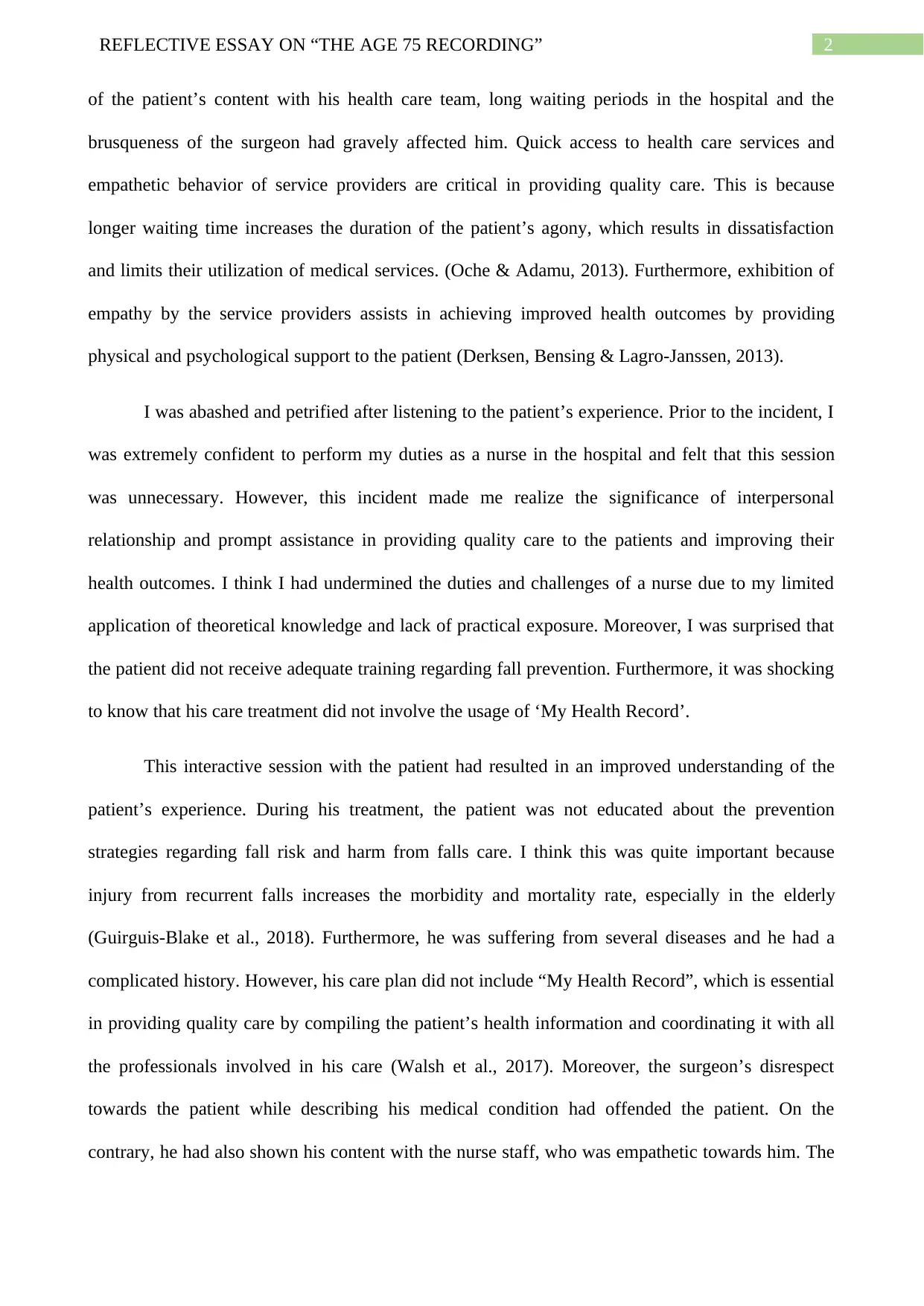
2REFLECTIVE ESSAY ON “THE AGE 75 RECORDING”
of the patient’s content with his health care team, long waiting periods in the hospital and the
brusqueness of the surgeon had gravely affected him. Quick access to health care services and
empathetic behavior of service providers are critical in providing quality care. This is because
longer waiting time increases the duration of the patient’s agony, which results in dissatisfaction
and limits their utilization of medical services. (Oche & Adamu, 2013). Furthermore, exhibition of
empathy by the service providers assists in achieving improved health outcomes by providing
physical and psychological support to the patient (Derksen, Bensing & Lagro-Janssen, 2013).
I was abashed and petrified after listening to the patient’s experience. Prior to the incident, I
was extremely confident to perform my duties as a nurse in the hospital and felt that this session
was unnecessary. However, this incident made me realize the significance of interpersonal
relationship and prompt assistance in providing quality care to the patients and improving their
health outcomes. I think I had undermined the duties and challenges of a nurse due to my limited
application of theoretical knowledge and lack of practical exposure. Moreover, I was surprised that
the patient did not receive adequate training regarding fall prevention. Furthermore, it was shocking
to know that his care treatment did not involve the usage of ‘My Health Record’.
This interactive session with the patient had resulted in an improved understanding of the
patient’s experience. During his treatment, the patient was not educated about the prevention
strategies regarding fall risk and harm from falls care. I think this was quite important because
injury from recurrent falls increases the morbidity and mortality rate, especially in the elderly
(Guirguis-Blake et al., 2018). Furthermore, he was suffering from several diseases and he had a
complicated history. However, his care plan did not include “My Health Record”, which is essential
in providing quality care by compiling the patient’s health information and coordinating it with all
the professionals involved in his care (Walsh et al., 2017). Moreover, the surgeon’s disrespect
towards the patient while describing his medical condition had offended the patient. On the
contrary, he had also shown his content with the nurse staff, who was empathetic towards him. The
of the patient’s content with his health care team, long waiting periods in the hospital and the
brusqueness of the surgeon had gravely affected him. Quick access to health care services and
empathetic behavior of service providers are critical in providing quality care. This is because
longer waiting time increases the duration of the patient’s agony, which results in dissatisfaction
and limits their utilization of medical services. (Oche & Adamu, 2013). Furthermore, exhibition of
empathy by the service providers assists in achieving improved health outcomes by providing
physical and psychological support to the patient (Derksen, Bensing & Lagro-Janssen, 2013).
I was abashed and petrified after listening to the patient’s experience. Prior to the incident, I
was extremely confident to perform my duties as a nurse in the hospital and felt that this session
was unnecessary. However, this incident made me realize the significance of interpersonal
relationship and prompt assistance in providing quality care to the patients and improving their
health outcomes. I think I had undermined the duties and challenges of a nurse due to my limited
application of theoretical knowledge and lack of practical exposure. Moreover, I was surprised that
the patient did not receive adequate training regarding fall prevention. Furthermore, it was shocking
to know that his care treatment did not involve the usage of ‘My Health Record’.
This interactive session with the patient had resulted in an improved understanding of the
patient’s experience. During his treatment, the patient was not educated about the prevention
strategies regarding fall risk and harm from falls care. I think this was quite important because
injury from recurrent falls increases the morbidity and mortality rate, especially in the elderly
(Guirguis-Blake et al., 2018). Furthermore, he was suffering from several diseases and he had a
complicated history. However, his care plan did not include “My Health Record”, which is essential
in providing quality care by compiling the patient’s health information and coordinating it with all
the professionals involved in his care (Walsh et al., 2017). Moreover, the surgeon’s disrespect
towards the patient while describing his medical condition had offended the patient. On the
contrary, he had also shown his content with the nurse staff, who was empathetic towards him. The
⊘ This is a preview!⊘
Do you want full access?
Subscribe today to unlock all pages.

Trusted by 1+ million students worldwide
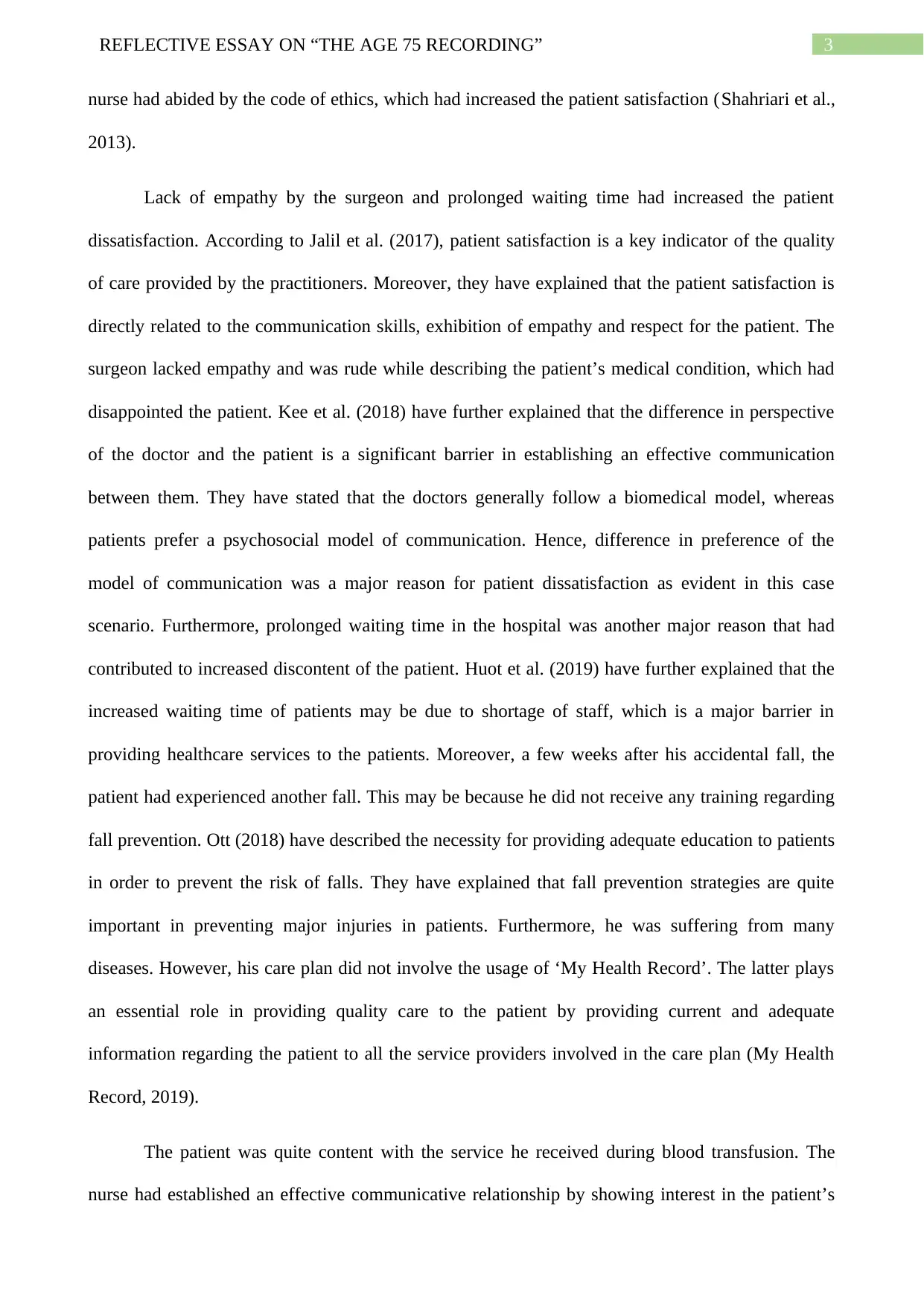
3REFLECTIVE ESSAY ON “THE AGE 75 RECORDING”
nurse had abided by the code of ethics, which had increased the patient satisfaction (Shahriari et al.,
2013).
Lack of empathy by the surgeon and prolonged waiting time had increased the patient
dissatisfaction. According to Jalil et al. (2017), patient satisfaction is a key indicator of the quality
of care provided by the practitioners. Moreover, they have explained that the patient satisfaction is
directly related to the communication skills, exhibition of empathy and respect for the patient. The
surgeon lacked empathy and was rude while describing the patient’s medical condition, which had
disappointed the patient. Kee et al. (2018) have further explained that the difference in perspective
of the doctor and the patient is a significant barrier in establishing an effective communication
between them. They have stated that the doctors generally follow a biomedical model, whereas
patients prefer a psychosocial model of communication. Hence, difference in preference of the
model of communication was a major reason for patient dissatisfaction as evident in this case
scenario. Furthermore, prolonged waiting time in the hospital was another major reason that had
contributed to increased discontent of the patient. Huot et al. (2019) have further explained that the
increased waiting time of patients may be due to shortage of staff, which is a major barrier in
providing healthcare services to the patients. Moreover, a few weeks after his accidental fall, the
patient had experienced another fall. This may be because he did not receive any training regarding
fall prevention. Ott (2018) have described the necessity for providing adequate education to patients
in order to prevent the risk of falls. They have explained that fall prevention strategies are quite
important in preventing major injuries in patients. Furthermore, he was suffering from many
diseases. However, his care plan did not involve the usage of ‘My Health Record’. The latter plays
an essential role in providing quality care to the patient by providing current and adequate
information regarding the patient to all the service providers involved in the care plan (My Health
Record, 2019).
The patient was quite content with the service he received during blood transfusion. The
nurse had established an effective communicative relationship by showing interest in the patient’s
nurse had abided by the code of ethics, which had increased the patient satisfaction (Shahriari et al.,
2013).
Lack of empathy by the surgeon and prolonged waiting time had increased the patient
dissatisfaction. According to Jalil et al. (2017), patient satisfaction is a key indicator of the quality
of care provided by the practitioners. Moreover, they have explained that the patient satisfaction is
directly related to the communication skills, exhibition of empathy and respect for the patient. The
surgeon lacked empathy and was rude while describing the patient’s medical condition, which had
disappointed the patient. Kee et al. (2018) have further explained that the difference in perspective
of the doctor and the patient is a significant barrier in establishing an effective communication
between them. They have stated that the doctors generally follow a biomedical model, whereas
patients prefer a psychosocial model of communication. Hence, difference in preference of the
model of communication was a major reason for patient dissatisfaction as evident in this case
scenario. Furthermore, prolonged waiting time in the hospital was another major reason that had
contributed to increased discontent of the patient. Huot et al. (2019) have further explained that the
increased waiting time of patients may be due to shortage of staff, which is a major barrier in
providing healthcare services to the patients. Moreover, a few weeks after his accidental fall, the
patient had experienced another fall. This may be because he did not receive any training regarding
fall prevention. Ott (2018) have described the necessity for providing adequate education to patients
in order to prevent the risk of falls. They have explained that fall prevention strategies are quite
important in preventing major injuries in patients. Furthermore, he was suffering from many
diseases. However, his care plan did not involve the usage of ‘My Health Record’. The latter plays
an essential role in providing quality care to the patient by providing current and adequate
information regarding the patient to all the service providers involved in the care plan (My Health
Record, 2019).
The patient was quite content with the service he received during blood transfusion. The
nurse had established an effective communicative relationship by showing interest in the patient’s
Paraphrase This Document
Need a fresh take? Get an instant paraphrase of this document with our AI Paraphraser
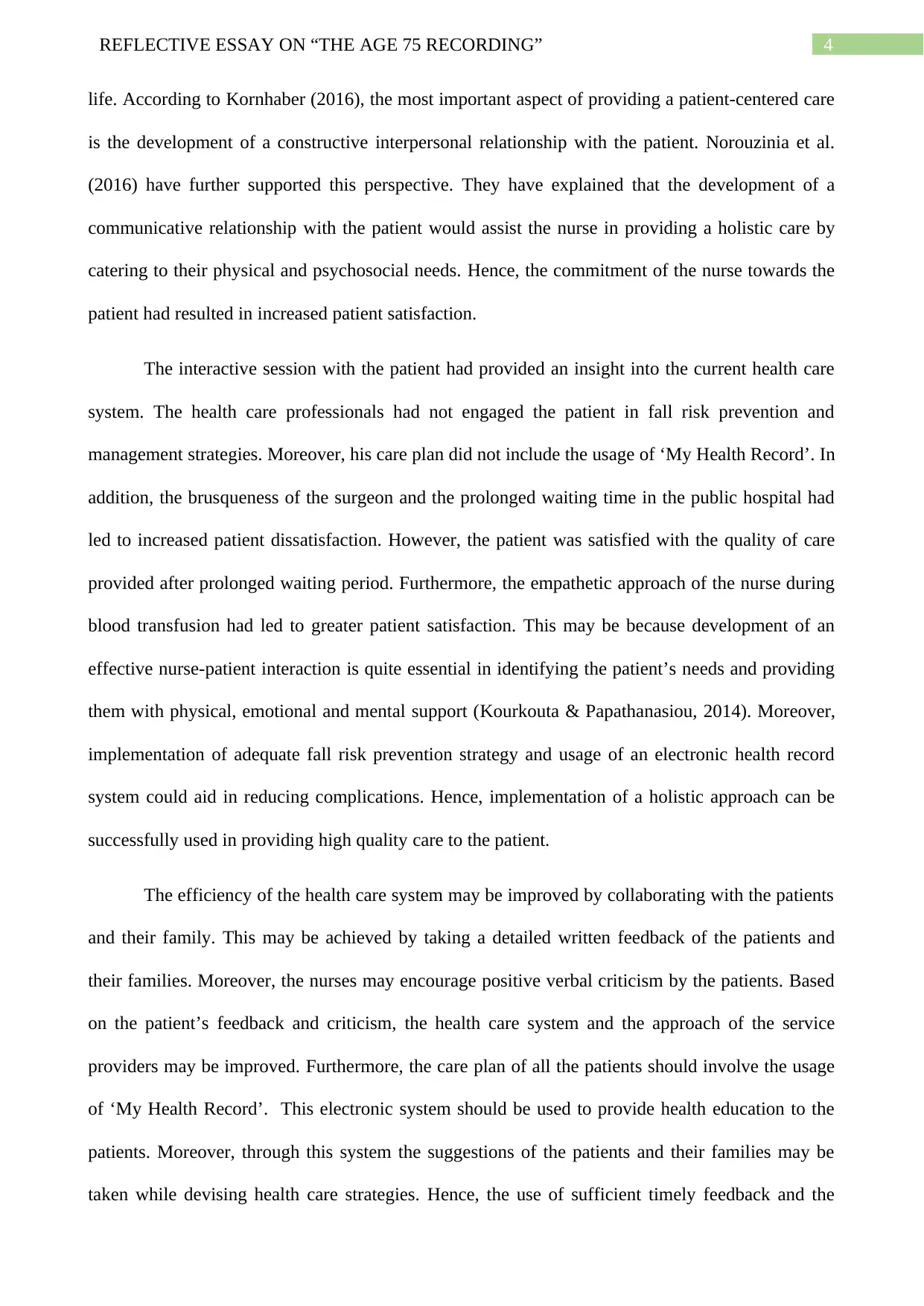
4REFLECTIVE ESSAY ON “THE AGE 75 RECORDING”
life. According to Kornhaber (2016), the most important aspect of providing a patient-centered care
is the development of a constructive interpersonal relationship with the patient. Norouzinia et al.
(2016) have further supported this perspective. They have explained that the development of a
communicative relationship with the patient would assist the nurse in providing a holistic care by
catering to their physical and psychosocial needs. Hence, the commitment of the nurse towards the
patient had resulted in increased patient satisfaction.
The interactive session with the patient had provided an insight into the current health care
system. The health care professionals had not engaged the patient in fall risk prevention and
management strategies. Moreover, his care plan did not include the usage of ‘My Health Record’. In
addition, the brusqueness of the surgeon and the prolonged waiting time in the public hospital had
led to increased patient dissatisfaction. However, the patient was satisfied with the quality of care
provided after prolonged waiting period. Furthermore, the empathetic approach of the nurse during
blood transfusion had led to greater patient satisfaction. This may be because development of an
effective nurse-patient interaction is quite essential in identifying the patient’s needs and providing
them with physical, emotional and mental support (Kourkouta & Papathanasiou, 2014). Moreover,
implementation of adequate fall risk prevention strategy and usage of an electronic health record
system could aid in reducing complications. Hence, implementation of a holistic approach can be
successfully used in providing high quality care to the patient.
The efficiency of the health care system may be improved by collaborating with the patients
and their family. This may be achieved by taking a detailed written feedback of the patients and
their families. Moreover, the nurses may encourage positive verbal criticism by the patients. Based
on the patient’s feedback and criticism, the health care system and the approach of the service
providers may be improved. Furthermore, the care plan of all the patients should involve the usage
of ‘My Health Record’. This electronic system should be used to provide health education to the
patients. Moreover, through this system the suggestions of the patients and their families may be
taken while devising health care strategies. Hence, the use of sufficient timely feedback and the
life. According to Kornhaber (2016), the most important aspect of providing a patient-centered care
is the development of a constructive interpersonal relationship with the patient. Norouzinia et al.
(2016) have further supported this perspective. They have explained that the development of a
communicative relationship with the patient would assist the nurse in providing a holistic care by
catering to their physical and psychosocial needs. Hence, the commitment of the nurse towards the
patient had resulted in increased patient satisfaction.
The interactive session with the patient had provided an insight into the current health care
system. The health care professionals had not engaged the patient in fall risk prevention and
management strategies. Moreover, his care plan did not include the usage of ‘My Health Record’. In
addition, the brusqueness of the surgeon and the prolonged waiting time in the public hospital had
led to increased patient dissatisfaction. However, the patient was satisfied with the quality of care
provided after prolonged waiting period. Furthermore, the empathetic approach of the nurse during
blood transfusion had led to greater patient satisfaction. This may be because development of an
effective nurse-patient interaction is quite essential in identifying the patient’s needs and providing
them with physical, emotional and mental support (Kourkouta & Papathanasiou, 2014). Moreover,
implementation of adequate fall risk prevention strategy and usage of an electronic health record
system could aid in reducing complications. Hence, implementation of a holistic approach can be
successfully used in providing high quality care to the patient.
The efficiency of the health care system may be improved by collaborating with the patients
and their family. This may be achieved by taking a detailed written feedback of the patients and
their families. Moreover, the nurses may encourage positive verbal criticism by the patients. Based
on the patient’s feedback and criticism, the health care system and the approach of the service
providers may be improved. Furthermore, the care plan of all the patients should involve the usage
of ‘My Health Record’. This electronic system should be used to provide health education to the
patients. Moreover, through this system the suggestions of the patients and their families may be
taken while devising health care strategies. Hence, the use of sufficient timely feedback and the
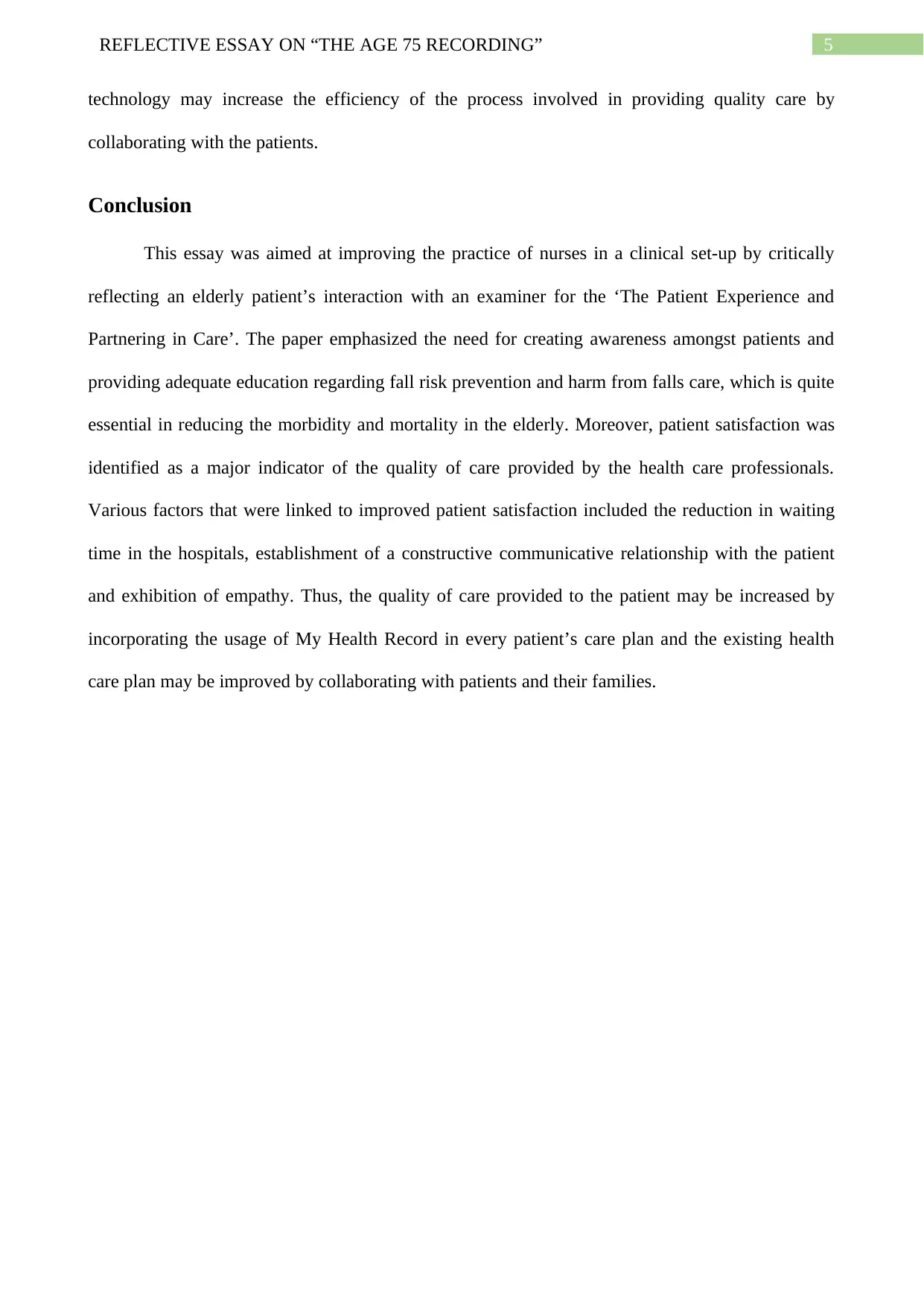
5REFLECTIVE ESSAY ON “THE AGE 75 RECORDING”
technology may increase the efficiency of the process involved in providing quality care by
collaborating with the patients.
Conclusion
This essay was aimed at improving the practice of nurses in a clinical set-up by critically
reflecting an elderly patient’s interaction with an examiner for the ‘The Patient Experience and
Partnering in Care’. The paper emphasized the need for creating awareness amongst patients and
providing adequate education regarding fall risk prevention and harm from falls care, which is quite
essential in reducing the morbidity and mortality in the elderly. Moreover, patient satisfaction was
identified as a major indicator of the quality of care provided by the health care professionals.
Various factors that were linked to improved patient satisfaction included the reduction in waiting
time in the hospitals, establishment of a constructive communicative relationship with the patient
and exhibition of empathy. Thus, the quality of care provided to the patient may be increased by
incorporating the usage of My Health Record in every patient’s care plan and the existing health
care plan may be improved by collaborating with patients and their families.
technology may increase the efficiency of the process involved in providing quality care by
collaborating with the patients.
Conclusion
This essay was aimed at improving the practice of nurses in a clinical set-up by critically
reflecting an elderly patient’s interaction with an examiner for the ‘The Patient Experience and
Partnering in Care’. The paper emphasized the need for creating awareness amongst patients and
providing adequate education regarding fall risk prevention and harm from falls care, which is quite
essential in reducing the morbidity and mortality in the elderly. Moreover, patient satisfaction was
identified as a major indicator of the quality of care provided by the health care professionals.
Various factors that were linked to improved patient satisfaction included the reduction in waiting
time in the hospitals, establishment of a constructive communicative relationship with the patient
and exhibition of empathy. Thus, the quality of care provided to the patient may be increased by
incorporating the usage of My Health Record in every patient’s care plan and the existing health
care plan may be improved by collaborating with patients and their families.
⊘ This is a preview!⊘
Do you want full access?
Subscribe today to unlock all pages.

Trusted by 1+ million students worldwide
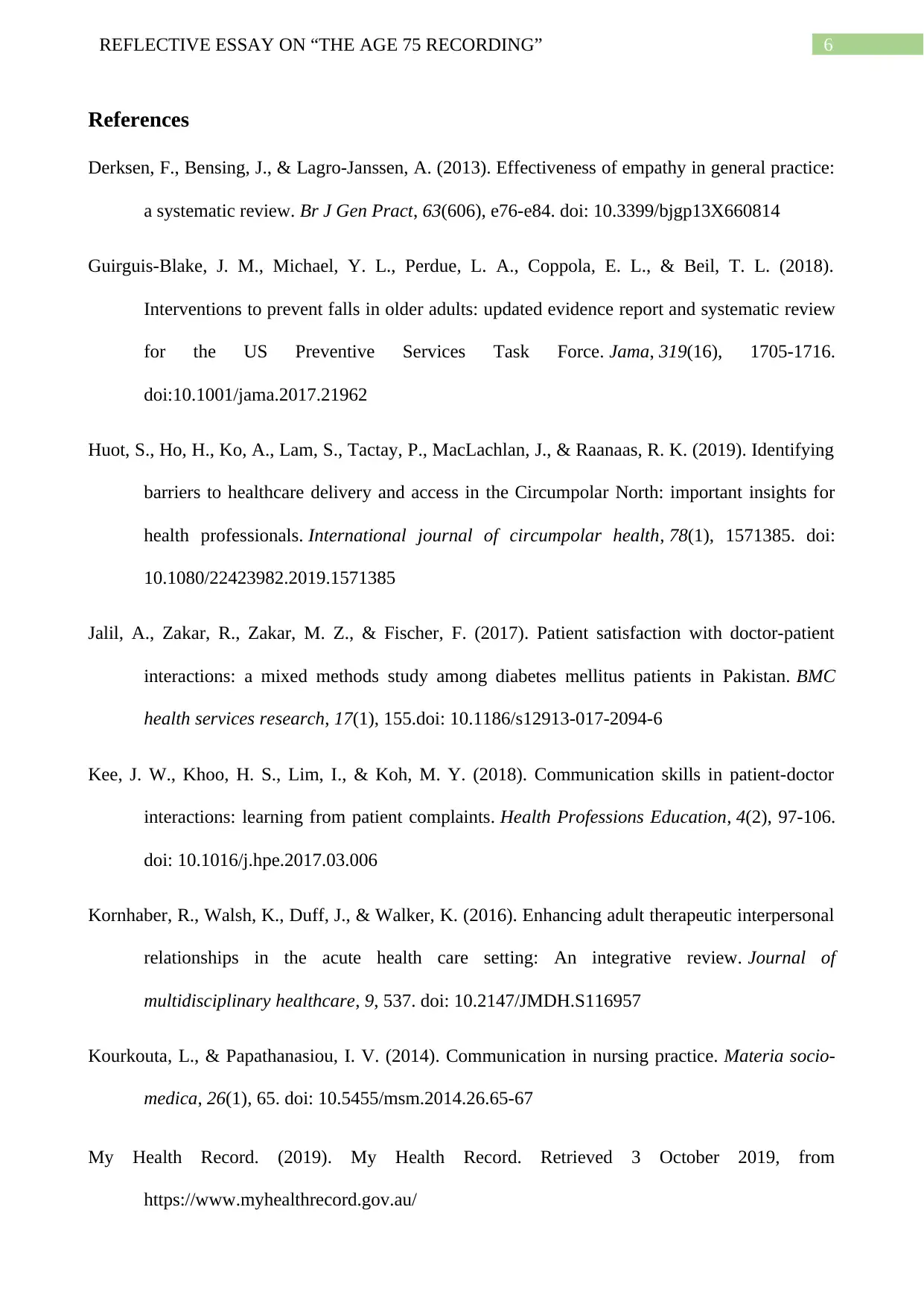
6REFLECTIVE ESSAY ON “THE AGE 75 RECORDING”
References
Derksen, F., Bensing, J., & Lagro-Janssen, A. (2013). Effectiveness of empathy in general practice:
a systematic review. Br J Gen Pract, 63(606), e76-e84. doi: 10.3399/bjgp13X660814
Guirguis-Blake, J. M., Michael, Y. L., Perdue, L. A., Coppola, E. L., & Beil, T. L. (2018).
Interventions to prevent falls in older adults: updated evidence report and systematic review
for the US Preventive Services Task Force. Jama, 319(16), 1705-1716.
doi:10.1001/jama.2017.21962
Huot, S., Ho, H., Ko, A., Lam, S., Tactay, P., MacLachlan, J., & Raanaas, R. K. (2019). Identifying
barriers to healthcare delivery and access in the Circumpolar North: important insights for
health professionals. International journal of circumpolar health, 78(1), 1571385. doi:
10.1080/22423982.2019.1571385
Jalil, A., Zakar, R., Zakar, M. Z., & Fischer, F. (2017). Patient satisfaction with doctor-patient
interactions: a mixed methods study among diabetes mellitus patients in Pakistan. BMC
health services research, 17(1), 155.doi: 10.1186/s12913-017-2094-6
Kee, J. W., Khoo, H. S., Lim, I., & Koh, M. Y. (2018). Communication skills in patient-doctor
interactions: learning from patient complaints. Health Professions Education, 4(2), 97-106.
doi: 10.1016/j.hpe.2017.03.006
Kornhaber, R., Walsh, K., Duff, J., & Walker, K. (2016). Enhancing adult therapeutic interpersonal
relationships in the acute health care setting: An integrative review. Journal of
multidisciplinary healthcare, 9, 537. doi: 10.2147/JMDH.S116957
Kourkouta, L., & Papathanasiou, I. V. (2014). Communication in nursing practice. Materia socio-
medica, 26(1), 65. doi: 10.5455/msm.2014.26.65-67
My Health Record. (2019). My Health Record. Retrieved 3 October 2019, from
https://www.myhealthrecord.gov.au/
References
Derksen, F., Bensing, J., & Lagro-Janssen, A. (2013). Effectiveness of empathy in general practice:
a systematic review. Br J Gen Pract, 63(606), e76-e84. doi: 10.3399/bjgp13X660814
Guirguis-Blake, J. M., Michael, Y. L., Perdue, L. A., Coppola, E. L., & Beil, T. L. (2018).
Interventions to prevent falls in older adults: updated evidence report and systematic review
for the US Preventive Services Task Force. Jama, 319(16), 1705-1716.
doi:10.1001/jama.2017.21962
Huot, S., Ho, H., Ko, A., Lam, S., Tactay, P., MacLachlan, J., & Raanaas, R. K. (2019). Identifying
barriers to healthcare delivery and access in the Circumpolar North: important insights for
health professionals. International journal of circumpolar health, 78(1), 1571385. doi:
10.1080/22423982.2019.1571385
Jalil, A., Zakar, R., Zakar, M. Z., & Fischer, F. (2017). Patient satisfaction with doctor-patient
interactions: a mixed methods study among diabetes mellitus patients in Pakistan. BMC
health services research, 17(1), 155.doi: 10.1186/s12913-017-2094-6
Kee, J. W., Khoo, H. S., Lim, I., & Koh, M. Y. (2018). Communication skills in patient-doctor
interactions: learning from patient complaints. Health Professions Education, 4(2), 97-106.
doi: 10.1016/j.hpe.2017.03.006
Kornhaber, R., Walsh, K., Duff, J., & Walker, K. (2016). Enhancing adult therapeutic interpersonal
relationships in the acute health care setting: An integrative review. Journal of
multidisciplinary healthcare, 9, 537. doi: 10.2147/JMDH.S116957
Kourkouta, L., & Papathanasiou, I. V. (2014). Communication in nursing practice. Materia socio-
medica, 26(1), 65. doi: 10.5455/msm.2014.26.65-67
My Health Record. (2019). My Health Record. Retrieved 3 October 2019, from
https://www.myhealthrecord.gov.au/
Paraphrase This Document
Need a fresh take? Get an instant paraphrase of this document with our AI Paraphraser
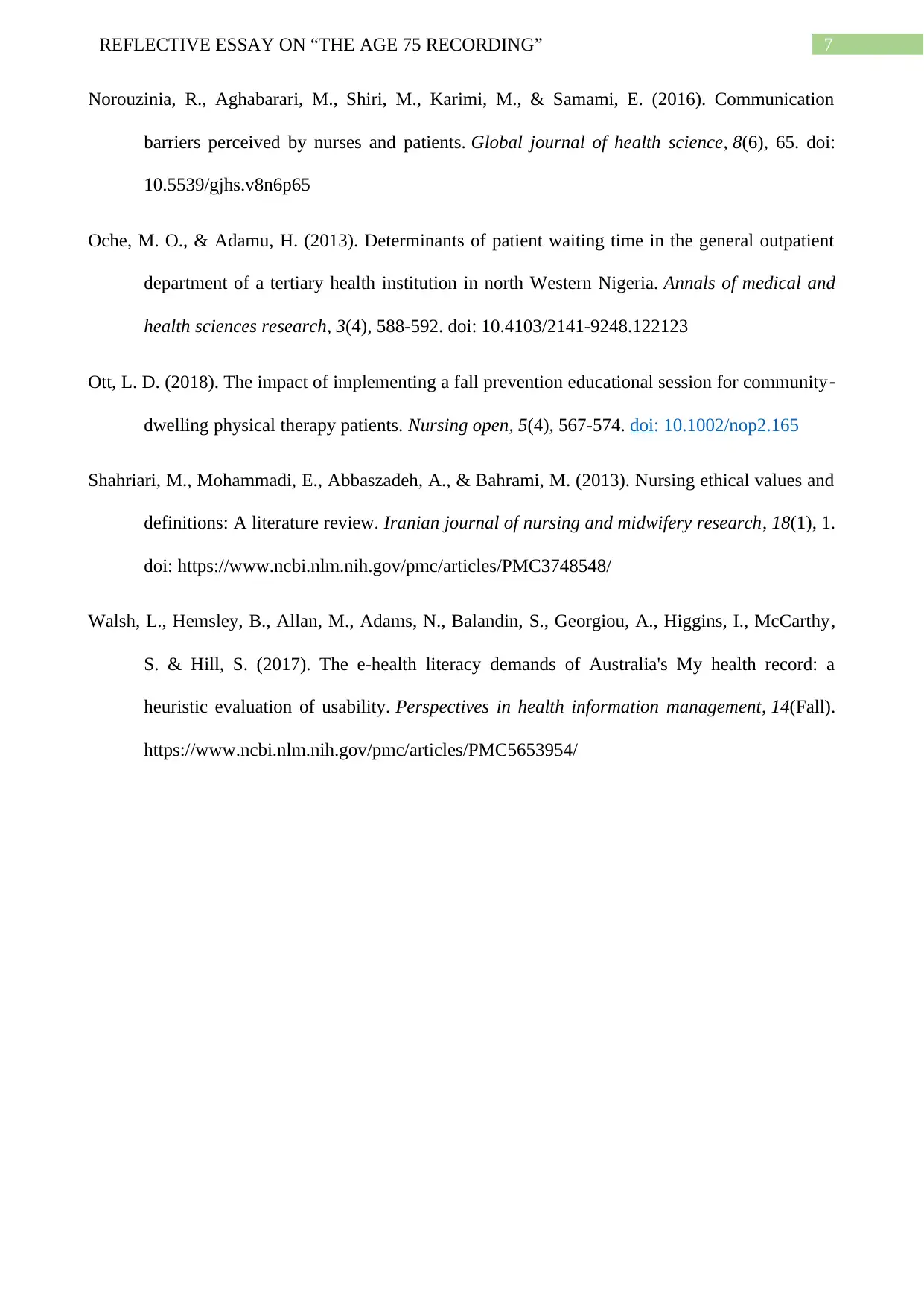
7REFLECTIVE ESSAY ON “THE AGE 75 RECORDING”
Norouzinia, R., Aghabarari, M., Shiri, M., Karimi, M., & Samami, E. (2016). Communication
barriers perceived by nurses and patients. Global journal of health science, 8(6), 65. doi:
10.5539/gjhs.v8n6p65
Oche, M. O., & Adamu, H. (2013). Determinants of patient waiting time in the general outpatient
department of a tertiary health institution in north Western Nigeria. Annals of medical and
health sciences research, 3(4), 588-592. doi: 10.4103/2141-9248.122123
Ott, L. D. (2018). The impact of implementing a fall prevention educational session for community‐
dwelling physical therapy patients. Nursing open, 5(4), 567-574. doi: 10.1002/nop2.165
Shahriari, M., Mohammadi, E., Abbaszadeh, A., & Bahrami, M. (2013). Nursing ethical values and
definitions: A literature review. Iranian journal of nursing and midwifery research, 18(1), 1.
doi: https://www.ncbi.nlm.nih.gov/pmc/articles/PMC3748548/
Walsh, L., Hemsley, B., Allan, M., Adams, N., Balandin, S., Georgiou, A., Higgins, I., McCarthy,
S. & Hill, S. (2017). The e-health literacy demands of Australia's My health record: a
heuristic evaluation of usability. Perspectives in health information management, 14(Fall).
https://www.ncbi.nlm.nih.gov/pmc/articles/PMC5653954/
Norouzinia, R., Aghabarari, M., Shiri, M., Karimi, M., & Samami, E. (2016). Communication
barriers perceived by nurses and patients. Global journal of health science, 8(6), 65. doi:
10.5539/gjhs.v8n6p65
Oche, M. O., & Adamu, H. (2013). Determinants of patient waiting time in the general outpatient
department of a tertiary health institution in north Western Nigeria. Annals of medical and
health sciences research, 3(4), 588-592. doi: 10.4103/2141-9248.122123
Ott, L. D. (2018). The impact of implementing a fall prevention educational session for community‐
dwelling physical therapy patients. Nursing open, 5(4), 567-574. doi: 10.1002/nop2.165
Shahriari, M., Mohammadi, E., Abbaszadeh, A., & Bahrami, M. (2013). Nursing ethical values and
definitions: A literature review. Iranian journal of nursing and midwifery research, 18(1), 1.
doi: https://www.ncbi.nlm.nih.gov/pmc/articles/PMC3748548/
Walsh, L., Hemsley, B., Allan, M., Adams, N., Balandin, S., Georgiou, A., Higgins, I., McCarthy,
S. & Hill, S. (2017). The e-health literacy demands of Australia's My health record: a
heuristic evaluation of usability. Perspectives in health information management, 14(Fall).
https://www.ncbi.nlm.nih.gov/pmc/articles/PMC5653954/
1 out of 8
Related Documents
Your All-in-One AI-Powered Toolkit for Academic Success.
+13062052269
info@desklib.com
Available 24*7 on WhatsApp / Email
![[object Object]](/_next/static/media/star-bottom.7253800d.svg)
Unlock your academic potential
Copyright © 2020–2025 A2Z Services. All Rights Reserved. Developed and managed by ZUCOL.





